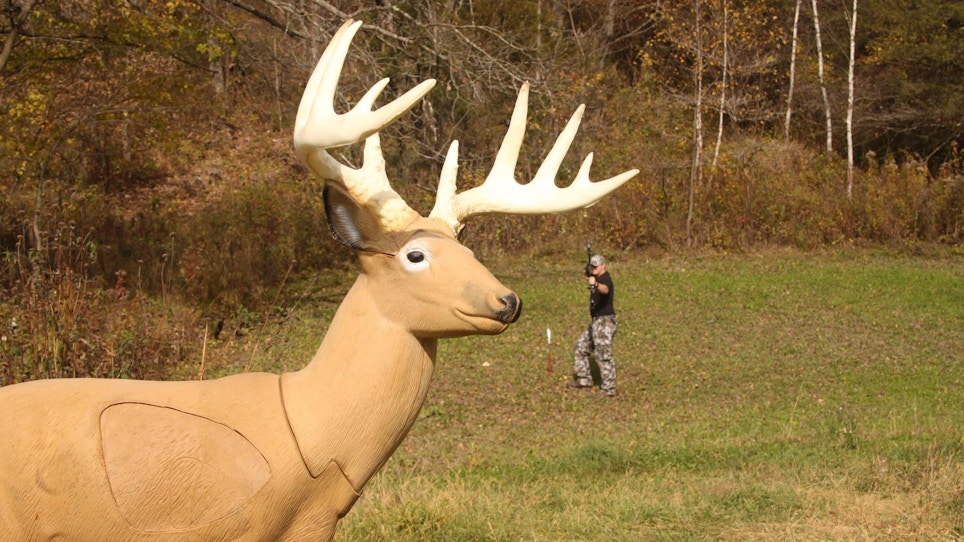 Shooting a bow is an athletic endeavor and — just like shooting a basketball, hitting a golf ball, or throwing a football — it takes practice to perfect the technique. But as legendary Green Bay Packers head coach Vince Lombardi once said, “Practice does not make perfect. Only perfect practice makes perfect.” Or as an old mentor told me one time as I was flailing away at the driving range, shanking golf balls hither and yon, “Well son, you’re doing a great job of grooving a bad swing.”
Shooting a bow is an athletic endeavor and — just like shooting a basketball, hitting a golf ball, or throwing a football — it takes practice to perfect the technique. But as legendary Green Bay Packers head coach Vince Lombardi once said, “Practice does not make perfect. Only perfect practice makes perfect.” Or as an old mentor told me one time as I was flailing away at the driving range, shanking golf balls hither and yon, “Well son, you’re doing a great job of grooving a bad swing.”
When you practice your bow shooting, do not groove a bad swing. Don’t just fling arrows to fling arrows; make the most of your range time. Here’s the Top 10 ways to practice perfectly.
1. Start Early
Not early in the morning -- though that’s when I shoot: five mornings a week, at dawn, before work. But, if you have not started getting ready for the upcoming archery seasons, that means start practicing now. If the last time you drew your bow was during last deer season, your bow-shooting muscles will need toning up. It takes several weeks. You may only be able to shoot a handful of arrows before your muscles get tired during those first few sessions, but that’s OK. When you get tired, stop, and come back tomorrow.
2. Hocus Focus
Every shot is important. Every one! Concentrate on drawing smoothly, anchoring consistently, precisely placing the sight pin on target, release crisply and following through. Proper form is everything. When -- not if, but when -- you start to get sloppy, take a break and don’t groove that bad swing. Some days you can shoot a lot of arrows before that happens, and some days only a few. When you begin to lose your concentration, pack it up and go home.
3. Call Your Shot
Because your sight pins will float through the bull’s eye and not sit rock-steady like a crosshair on a riflescope, you have to be able to call your shot. When the arrow was released, was the pin on target, or did it float a little high and left, or low and right? If you can call your shot, you know you’re concentrating and using correct form.
4. Don’t Fight the Sight
That’s a saying I made up years ago. It simply means if my arrows are consistently hitting off-center – rather than wonder why – I adjust my sight until I’m back on target. A compound bow and its sight are finicky, and lots of things can change point of impact from week to week, and even day to day: ambient air temperature, humidity, did the sight get bumped riding in the truck, all sorts of things. I find that it takes me several shooting sessions to get my sight precisely dialed up. I also make sure I regularly check every on screw on my bow to make sure nothing has rattled loose. I check the string for fraying, make sure my peep hasn’t scooted up or down the string and so on.
5. Hold It!
How many times have you come to full draw on an animal and then, for a zillion reasons big and small, been forced to hold your bow at full draw until a quality shot presents itself? Your arms fatigue, then your breath comes in short, ragged puffs, your eyes water. When you can finally release, you forget about keeping that bow arm up and following through -- and miss the shot. To avoid this scenario, I consciously force myself to draw and hold for 30 seconds or more before releasing the arrow. I do this only after I’ve been shooting for a while and everything seems golden. The 30-second hold helps develop stamina needed to make this shot and it emphasizes the importance of maintaining your shooting form no matter what.
6. Shoot Now!
Tennis legend Billie Jean King once said, “Victory is fleeting. Losing is forever.” There are times when a shot opportunity quickly presents itself, and offers you no more than a few seconds to make it happen before that critter walks out of your life forever. That’s why I always practice shooting quickly, seeing the target, coming to full draw, and releasing the arrow in three seconds or less. Of course, accuracy is the most important thing. When hunting, if the shot opportunity is quick but my sight picture is poor, I don’t release the arrow. It takes practice to get this routine down pat.
7. Shoot 3D Targets
Just as shooting a rifle from a bench rest is great for dialing the sight in and getting back in the groove, shooting arrows at spots on paper or cube-type foam targets is great for tuning up your form and bow. Neither, however, replicates shooting at an animal. A 3D target does. You can buy one for less than a hundred bucks, and it will be worth every penny. Or if you’re lucky, you’ll find a public shooting range close to home that has a roving 3D course available. The 3D target allows you to see how various shot angles dictate sight pin placement.
8. Specificity Training
Athletes train to excel at a specific task. Running sprints fast, for instance, is not the same as running long distance. To that end, training regimens are different. Bowhunters should also train specifically for their upcoming hunting trip. If you’re treestand whitetail hunting, shoot from an elevated platform. Hunting from a ground blind? Then sit in a chair and shoot that way. Spot-and-stalk, western hunting? Best practice some shooting from your knees and also at steep uphill and downhill angles. Whatever the case may be, replicate anticipated shot opportunities as closely as possible during practice sessions.
9. Dawn and dusk
Let’s face it. The best opportunities for a shot at a mature critter often occur in the first and last hour of the day. Sometimes it’s the first and last 30 minutes. I make sure I shoot a lot of arrows on the cusp of daylight so I know what my sight picture will be like. Is my peep large enough to allow sufficient light through at this hour? How do deep shadows affect how my sight pin appears on the chest of my 3D target? Because I hunt out West a lot, I also make sure I practice shooting in a stiff wind.
BONUS TIP: Kneeling really helps mitigate how much a crosswind will bounce the bow around.
10. Shoot hunting arrows and broadheads
Never, ever go hunting without practicing with the exact same arrows and broadheads you’ll be hunting with. Never, ever assume that your broadheads fly exactly like field points without confirming this for yourself. You might end up ruining a three-pack of expensive broadheads and tearing up a broadhead target in the process, but so what? This is the right and ethical thing to do. When I shot replaceable-blade broadheads all the time, I wore out one, and sometimes two, hundred-dollar targets and a dozen or more broadheads a year practicing. Mechanical heads can more easily be made to fly like field points, and so much of my practice now is with field tips. BUT I never, ever go hunting without first shooting the broadhead itself at a target. That may mean throwing it away and getting a new one before hunting, but I’m OK with that.
Featured image: Rinehart Targets
How about you? What’s your practice routine? Can you give us tips on how we can practice better? Drop me a note at brobb@grandviemedia.com and share your thoughts, I’d love to hear them!






